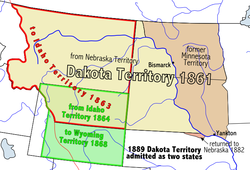Dakota Territory
| Territory of Dakota | |||||
| Organized incorporated territory of the United States | |||||
|
|||||
| Capital |
Yankton (1861–1883) Bismarck (1883–1889) |
||||
| Government | Organized incorporated territory | ||||
| Governor | List | ||||
| History | |||||
| • | Created from Nebraska and unorganized territories | March 2, 1861 | |||
| • | Idaho Territory split off | March 4, 1863 | |||
| • | Land received from Idaho Territory | May 28, 1864 | |||
| • | Wyoming Territory split off | July 25, 1868 | |||
| • | North Dakota and South Dakota statehood | November 2, 1889 | |||
The Territory of Dakota was an organized incorporated territory of the United States that existed from March 2, 1861, until November 2, 1889, when the final extent of the reduced territory was split and admitted to the Union as the states of North and South Dakota.
The Dakota Territory consisted of the northernmost part of the land acquired in the Louisiana purchase in 1803, as well as the southmost part of Rupert's Land, which was acquired in 1818 when the boundary was changed to the 49th parallel. The name refers to the Dakota branch of the Sioux tribes which occupied the area at the time. Most of Dakota Territory was formerly part of the Minnesota and Nebraska territories.
When Minnesota became a state in 1858, the leftover area between the Missouri River and Minnesota's western boundary fell unorganized. When the Yankton Treaty was signed later that year, ceding much of what had been Sioux Indian land to the U.S. Government, early settlers formed an unofficial provisional government and unsuccessfully lobbied for United States territory status.
Three years later President-elect Abraham Lincoln's cousin-in-law, J.B.S. Todd, personally lobbied for territory status and the U.S. Congress formally created Dakota Territory. It became an organized territory on March 2, 1861. Upon creation, Dakota Territory included much of present-day Montana and Wyoming as well as all of present-day North Dakota and South Dakota and a small portion of present-day Nebraska.
...
Wikipedia

